h0gr1der
New member
Disclaimer- Don't do this, it may cause the wheels to fall off!
So you’ve procured some Made In XXXX (Preferred Country of Choice) bearings off of the InterWebs! Did you know that the bearing has a specified shelf life as denoted by the manufacturer? All bearings do. The oil slowly seeps out of the base, and or decomposes over time (a relatively long time, but nonetheless).
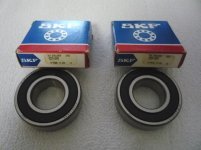
So, the best thing to do is inspect them closely and maybe clean and repack them. If they’ve been sitting in a non climate controlled location for 10 years, they may be pitted inside. If you want to inspect them get a very small (I use a jewelers) screwdriver, and gently work it through the seal against the inside race. Align the flat point blade against the race and slide it gently under the lip, then it will easily go to the inside. Pry up and the seal should pop out of the outside race. Then you can just walk it around and remove it. Do both sides. Don’t know if you can remove metal shields on electric motor bearings though.
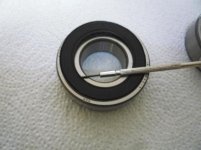
You may be alarmed at the small quantity of grease in the bearing. From what I’ve learned the bearing is filled about 30% from most manufacturers. Grease quantities are generally for much higher shaft speeds than the Spyder can put on the bearings, with ±14,000 rated RPM’s with grease that the bearings are rated for as far as speed and heat. Spyders turn 845 rear wheel RPM or less at 60 MPH (225/50R15-845 revolutions per mile @ 1 mile per minute), so double that and get 1690 RPM’s at 120 MPH). Nowhere near the rated ±14,000 RPM’s, only 12.1% of rating. Very lightly loaded. With that lower RPM you can carry a bigger grease load, but never, ever fill the bearing full. 50-60% fill is good.
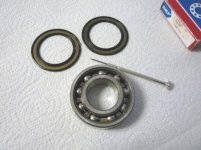
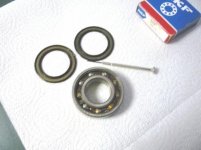
Clean the bearings. A lot of greases used in ball bearings are very incompatible with other greases. I flush it out and then blow it with air. Never spin a bearing with air; they can kill you if they come apart. Always protect your eyes and hands when doing this kind of stuff. Let any solvents dry out completely after cleaning the bearing.
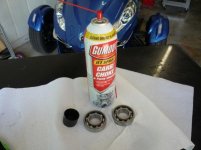
Repack with your favorite grease. Almost any good disc brake rated grease will work, as long as its NLGI2 and disc brake rated. I won’t tell you what I use, wouldn’t want to influence you. Do not fill the bearing cavity full; a 50% fill is adequate. Press the seals back in place and spin the bearing to distribute the grease. Don’t want to start this bearing with any non-lubricated rollers.
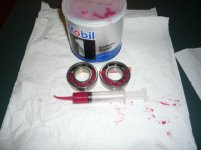
So you’ve procured some Made In XXXX (Preferred Country of Choice) bearings off of the InterWebs! Did you know that the bearing has a specified shelf life as denoted by the manufacturer? All bearings do. The oil slowly seeps out of the base, and or decomposes over time (a relatively long time, but nonetheless).

So, the best thing to do is inspect them closely and maybe clean and repack them. If they’ve been sitting in a non climate controlled location for 10 years, they may be pitted inside. If you want to inspect them get a very small (I use a jewelers) screwdriver, and gently work it through the seal against the inside race. Align the flat point blade against the race and slide it gently under the lip, then it will easily go to the inside. Pry up and the seal should pop out of the outside race. Then you can just walk it around and remove it. Do both sides. Don’t know if you can remove metal shields on electric motor bearings though.

You may be alarmed at the small quantity of grease in the bearing. From what I’ve learned the bearing is filled about 30% from most manufacturers. Grease quantities are generally for much higher shaft speeds than the Spyder can put on the bearings, with ±14,000 rated RPM’s with grease that the bearings are rated for as far as speed and heat. Spyders turn 845 rear wheel RPM or less at 60 MPH (225/50R15-845 revolutions per mile @ 1 mile per minute), so double that and get 1690 RPM’s at 120 MPH). Nowhere near the rated ±14,000 RPM’s, only 12.1% of rating. Very lightly loaded. With that lower RPM you can carry a bigger grease load, but never, ever fill the bearing full. 50-60% fill is good.


Clean the bearings. A lot of greases used in ball bearings are very incompatible with other greases. I flush it out and then blow it with air. Never spin a bearing with air; they can kill you if they come apart. Always protect your eyes and hands when doing this kind of stuff. Let any solvents dry out completely after cleaning the bearing.

Repack with your favorite grease. Almost any good disc brake rated grease will work, as long as its NLGI2 and disc brake rated. I won’t tell you what I use, wouldn’t want to influence you. Do not fill the bearing cavity full; a 50% fill is adequate. Press the seals back in place and spin the bearing to distribute the grease. Don’t want to start this bearing with any non-lubricated rollers.

